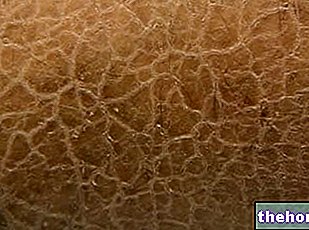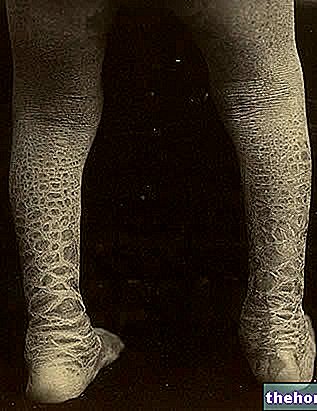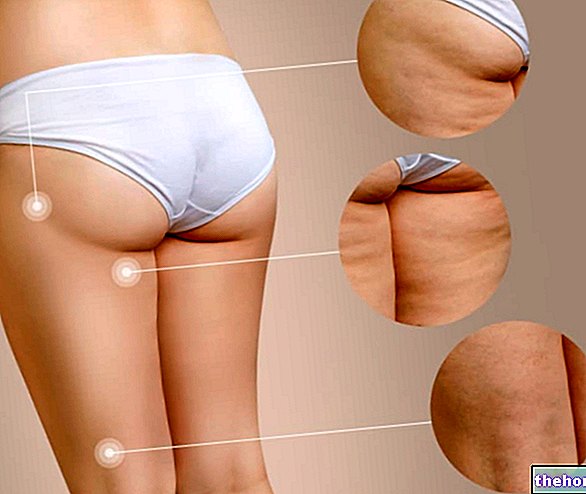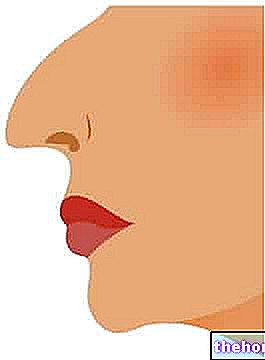Definition
The term ichthyosis is intended to indicate a series of skin diseases defined as "genodermatosis", ie genetic disorders whose effects occur on the skin.

The term "ichthyosis" comes from the Greek word "Iχτυς ", whose meaning is" fish "and indicates the typical scaly appearance that the skin of patients affected by these diseases assumes.
Classification
Ichthyosis is not only a disease in its own right, but often it is related to other pathologies and can be the cause or the consequence; the classification of the various types of ichthyosis is problematic, precisely due to the fact that the disease has various facets.
A first major classification is that which divides the different types of ichthyosis into hereditary and acquired forms.
Hereditary forms, of course, are present from birth, as genetic alterations are passed on from the parents.
The acquired forms, on the other hand, occur in adulthood, usually in association with other pathologies of various origins and nature, such as, for example, tumors (lymphomas, lung, liver, breast or kidney cancer, etc.), Crohn's disease, thyroid gland disease or AIDS.
However, in general, ichthyoses are divided into categories based on the resulting clinical picture. In this regard, we can distinguish:
- X-linked ichthyosis;
- L "lamellar ichthyosis;
- L "ichthyosis vulgaris;
- L "epidermolytic hyperkeratosis;
- The Harlequin ichthyosis;
- Ichthyosiform congenital erythroderma.
A "other classification of the different types of ichthyosis - defined as" ultrastructural classification "- provides for the subdivision into four types (type I, II, III and IV) according to the structural characteristics of the epidermal cells subjected to biopsy. , it is used only for hereditary forms and not for acquired forms.
Finally, a "further classification used to divide the forms of hereditary ichthyosis provides for their grouping into:
- Syndromic ichthyoses, ie ichthyoses that occur both in the skin and in other organs;
- Non-syndromic ichthyosis, i.e. types of ichthyosis that occur only in the skin.
Incidence

Severe ichthyosis of the legs. Image from en.wikipedia.org - See More Photos Ichthyosis
Excluding ichthyosis vulgaris, these diseases are rare forms, which occur mostly in one subject every 3,000 people; X-linked ichthyosis and Harlequin ichthyosis have an incidence index of 1: 300,000, respectively. and 1: 500,000 / 1,000,000.
Due to the rarity of the incidence, Harlequin ichthyosis is sometimes excluded from the common list of ichthyoses.
Types of ichthyosis
The table below lists the most well-known types of ichthyosis and summarizes the main characters that distinguish one form from another.
(1: 500.000)
* An entire article will be dedicated to the "Ichthyosis Arlecchino, given its peculiarity and rarity. Other insights: Ichthyosis Vulgaris
Finally, remember that among the various forms of ichthyosis, there is also xerosis, the lightest and least severe form of the skin disease. Generally, xerosis affects lower and upper limbs, manifesting dryness of the skin associated with mild itching, which worsens during the winter season. The itchy sensation is enhanced by the use of aggressive and irritating detergents, which eradicate the protective lipid layer of the skin.
Diagnosis
Since these are relatively rare diseases, the diagnosis of ichthyosis is not always easy to make.
In any case, the first step in diagnosing the disease is certainly the physical examination which involves the analysis of the scales and lamellae that form on the skin of the patients. In detail, the doctor will evaluate their appearance and distribution on the body, also determining the possible presence of vesicles.
The doctor will then investigate the patient's family history since ichthyosis is a hereditary disease.
In order to discriminate which form of ichthyosis affects the patient, the doctor can then resort to tests such as biopsy, which can be associated with molecular genetic analysis in order to definitively confirm the diagnosis.
Finally, some forms of ichthyosis can also be diagnosed prenatally. For example, X-linked ichthyosis can be diagnosed by performing amniocentesis; while lamellar ichthyosis, Harlequin ichthyosis and epidermolytic hyperkeratosis can be diagnosed prenatally by performing fetoscopy.
Symptoms
For further information: Ichthyosis Symptoms
The first symptoms of hereditary ichthyosis usually appear shortly after birth, or in any case within the first year of the baby's life.
Ichthyosis can manifest itself simply with dry skin, or it can lead to more serious forms, presenting thickening of the skin associated with scales and lamellae that disfigure and disfigure the image of the person and that can create more or less serious problems for individuals who are affections.
The alteration of keratinization, in fact, involves the accumulation and superimposition of dead cells one on the other, which flake the skin connoting it with the typical characteristics of dry skin (more marked phenomenon in the rare forms of ichthyosis).
The severity of the skin thickening and the formation of scales and lamellae depends on the form of ichthyosis from which the patient suffers. Depending on their severity, the cutaneous manifestations of ichthyosis can lead to consequences - sometimes even very serious - both physical and psychological.
In other cases, on the other hand, ichthyosis can itself be the symptom of other basic pathologies affecting the patient (see the chapter "Associated diseases"). This is the case of acquired ichthyosis.
Predisposing factors
Since skin dryness is one of the typical symptoms of the various forms of ichthyosis, the cold and dry climate could enhance and favor the ichthyotic manifestation, but it can never represent the triggering cause, since ichthyoses are genetic pathologies.
Complications
As just stated, the cutaneous symptoms of the various types of ichthyosis can lead to various physical and psychological consequences. The severity of these consequences is generally greater the more severe the form of ichthyosis from which the patient suffers.
Physical complications
Depending on the area of the body in which the symptoms of ichthyosis occur, various complications can occur due to skin thickening, such as:
- Difficulty moving and walking, especially if ichthyosis occurs in the soles of the feet;
- Changes in hair growth
- Difficulty closing your eyes
- Difficulty in perspiration, as the thickening of the skin can hinder this physiological process.
Furthermore, the dryness and thickening of the skin that occur in individuals with ichthyosis make the skin inelastic and favor its breakage. The skin that is cracked and no longer intact is so easily exposed to the contraction of possible bacterial, viral or fungal infections that are.
Psychological complications
The appearance of an individual affected by ichthyosis can be profoundly altered, leading, in some cases, to serious psychological complications. Generally, children and adolescents are the most affected by this type of consequence, since the "physical appearance" is different ". and any resulting physical complications can make encounters and relationships with peers very difficult.
Associated diseases
As mentioned above, ichthyosis can be a symptom of other diseases: Refsum syndrome and Sjögren-Larsson syndrome are two examples.
The first represents a rare hereditary pathology involving ataxia (loss of muscle coordination), polyneuritis (inflammation of the nerves) and deafness; while the second syndrome is associated with muscle paralysis with progressive mental retardation.
Leprosy, AIDS and hypothyroidism represent three other pathologies that begin with different forms of acquired ichthyosis; sarcoidosis also manifests typical signs of ichthyosis (consistent and developed scales in the lower limbs). The biopsy of the skin affected by ichthyosis does not always give good results, indeed, in most cases it is useless for the diagnosis.
Treatment
Considering that ichthyosis is included among the genetically transmissible diseases, the cure is almost impossible.
However, there are some treatments that can be carried out in order to alleviate the symptoms. In this regard we can distinguish the topical treatment from the systemic treatment. However, the latter cannot be used on all ichthyosis patients.
Topical treatment
The topical treatment of ichthyosis aims to reduce skin thickening and restore lost moisture to the skin.
To achieve the first objective, normally, we resort to the use of pharmaceutical preparations (creams or lotions) based on keratolytic agents that are able to eliminate skin scales.
In this regard, active ingredients such as salicylic acid, urea and alpha-hydroxy acids (such as, for example, glycolic acid) are particularly useful.
In some cases, moreover, the use of topical drugs (creams, lotions, gels, ointments, etc.) based on retinoids may prove to be effective.
However, the use of these substances is certainly not free from side effects. The alpha-hydroxy acids, in fact, could be irritating to the dry and dehydrated skin of individuals suffering from ichthyosis. In the presence of cuts and cracks, moreover, the aforementioned principles active ingredients could be absorbed causing potentially serious side effects even at a systemic level.
For this reason, the topical treatment of ichthyosis must always take place under the strict supervision of the physician.
To give the skin the lost hydration and elasticity, however, it may be useful to use moisturizing products and products based on vaseline and emollient substances, very useful and highly recommended to soften the skin.
In case the ichthyosis is caused by a systemic disorder, it would be good to lubricate the affected areas with substances such as propylene glycol (humectant). This substance is also effective in alleviating the symptoms deriving from lamellar ichthyosis or X-linked ichthyosis. children, occlusive bandages are not recommended.
Systemic treatment
For most ichthyotic diseases, retinoids are a very effective treatment, which does not completely fight the disease, but can certainly heal the symptoms. Retinoids are administered orally.
In any case, in general, the systemic use of retinoids is advisable in the most severe cases of ichthyosis. In other cases, on the other hand, their use topically associated with the local application of preparations that promote the emollient, nourishing and keratolytic action (petroleum jelly, urea, glycerin, glycolic and salicylic acid) may be sufficient.
In any case, it should be remembered that retinoids taken orally can cause various side effects (such as increased blood levels of triglycerides), particularly when used for long periods of time, as in the case of patients suffering from ichthyosis. .
Furthermore, it should not be forgotten that retinoids are potential teratogens and, consequently, their use is absolutely forbidden during pregnancy.
In subjects suffering from epidermolytic hyperkeratosis, on the other hand, the ideal treatment is represented by cloxacillin or erythromycin, antibiotics useful in the prevention of pain associated with malodorous pustules that form following the contraction of a bacterial superinfection.
Psychological treatment
In the event that ichthyosis leads to psychological and social complications - in addition to pharmacological treatment aimed at relieving the skin symptoms of the disease - it will also be necessary to provide the patient with adequate psycho-social support and support, in order to avoid further and more serious complications.
Useful tips
To improve the effectiveness of ichthyosis treatments - whether topical or systemic - and to obtain relief from the symptoms of the disease, it may be useful to adopt small measures, such as:
- Reduce the frequency of washing to avoid aggravating skin irritation;
- Do not use toxic, highly absorbent substances (eg hexachlorophene, bactericidal / disinfectant substance) and irritating products;
- Prefer the use of delicate detergents, even better if prescribed or recommended by the doctor;
- Avoid direct and excessive exposure to atmospheric agents that can dry, dehydrate and further irritate the skin (sun, wind, cold, etc.);
- Always and scrupulously follow the doctor's instructions and never rely on do-it-yourself.
For further information: Drugs for the treatment of "Ichthyosis"




























